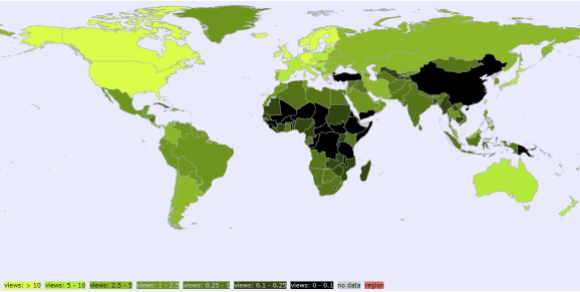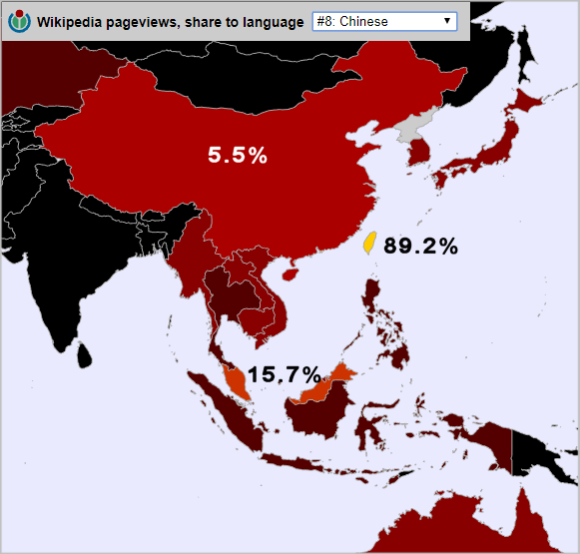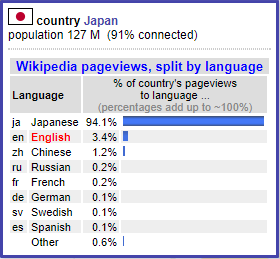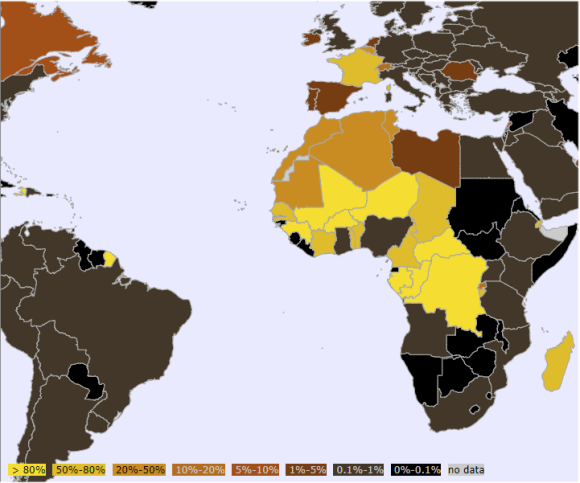
We recently released a new interactive visualization of Wikipedia traffic by country and language. Called WiViVi, which stands for Wikipedia Views Visualized, the new visualization shows the geographic distribution of pageviews to any or all Wikipedias from two different perspectives:
- Which Wikipedia languages are most read within various countries around the globe.
- How much Wikipedia is visited, per capita, within countries around the globe.
Documentation for the visualization, which allows much more detail by region, country, or language, is available on Meta-Wiki. There are three main ways to explore the data to help get you started.
- Wikipedia readership from any given country: In the mode “Wikipedia pageviews, percentage to any language,” you can see the Wikipedia readership from any given country. For example, hovering over the country of South Africa will display its population and data on internet penetration. You’ll learn that the majority of pageviews to Wikipedia within South Africa go to the English-language version of Wikipedia. Afrikaans, one of South Africa’s official languages, accounts for just 2.5% of Wikipedia pageviews originating from the country.
- Wikipedia readership for any given language: In the same map, let’s say you want to know what countries in the world send the most traffic to Portuguese Wikipedia. A language selector allows you to display statistics about monthly page views to the Portuguese Wikipedia, along with a breakdown by country of origin. Brazil makes up 73.0% of all traffic to Portuguese Wikipedia, with 250 million pages monthly, followed by views from the United States, Portugal, and Angola.
- Pageviews per capita to Wikipedia in any language in a given month: Switching to “Show pageviews to any language” and selecting a region like “Global North” will show you the breakdown of pageviews to any Wikipedia by population and monthly pageviews, along with the percentage of global traffic.
———
Interesting facts we’ve learned
The dashboard allows us to analyze Wikipedia traffic in various ways. For instance, you can see how a country’s language distribution often doesn’t reflect the ratio of language speakers in the same country at all.
- Language preferences per country
About 13% of the US population speak Spanish, but only 1.6% of pageviews from the US go to the Spanish Wikipedia. Conversely, we can see that 92% of pages read from India are in English. Indian English-speakers number more than twice the UK’s population, but are still a small fraction of the country’s 1.3 billion inhabitants. Similarly, 97% of pages read on Wikipedia in Nigeria are in English. Igbo, one of the country’s major languages, only accounts for 1%.
- Wikipedias’ reach per region/country

Countries with relatively few pageviews per capita include China, Turkey, and many countries in Africa. Unfortunately, this includes some countries where people do not have the freedom to access Wikipedia. Wikipedia in all languages is blocked in Turkey, and Chinese Wikipedia is blocked in China.
The share of pageviews from mainland China to the Chinese Wikipedia is remarkably low, presumably as Chinese Wikipedia remains inaccessible from mainland China, while other language versions remain available. As a consequence, the share of pageviews to other Wikipedia language editions from China is unexpectedly high. In Taiwan, however, the Chinese Wikipedia captures more than 89% of all pageviews.

Compared to other countries where the English language edition is read by a considerable fraction of readers, Japan is a striking exception, where very few people (3.4%) read the English Wikipedia.

- Where geography and history meet
The French language presents one example of a colonial legacy that still affects a number of countries today.

This visualization shows all countries where the percentage of pageviews to the French Wikipedia is above 50% (share of pageviews from France to French Wikipedia is 76.3%, for many countries in Africa it’s even above 80%).
We invite you to peruse these maps and share with us any interesting facts you may come across.
Erik Zachte, Data Analyst (Contractor), Wikimedia Foundation
All images are via the WiViVi visualization by Erik Zachte/Wikimedia Foundation, CC BY-SA 4.0. Thanks to Melody Kramer for her help in preparing this post.

Can you help us translate this article?
In order for this article to reach as many people as possible we would like your help. Can you translate this article to get the message out?
Start translation